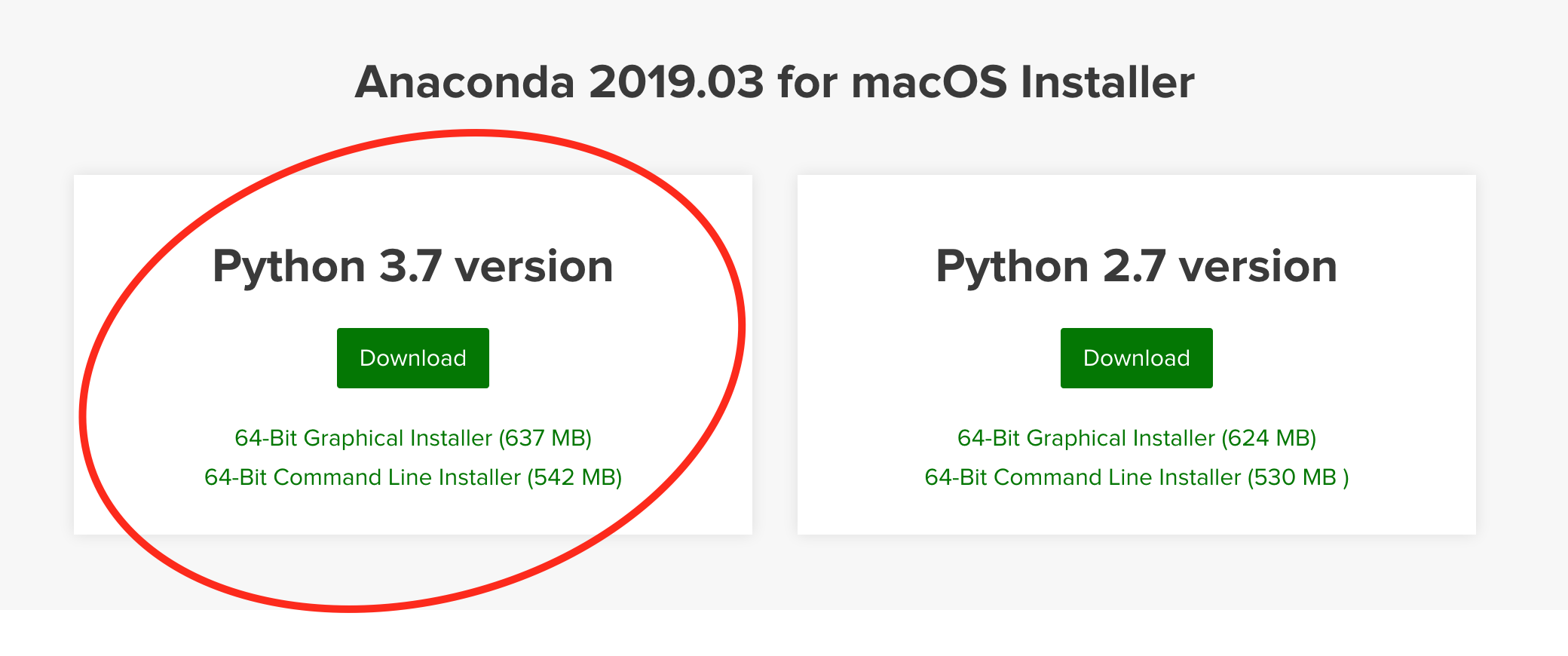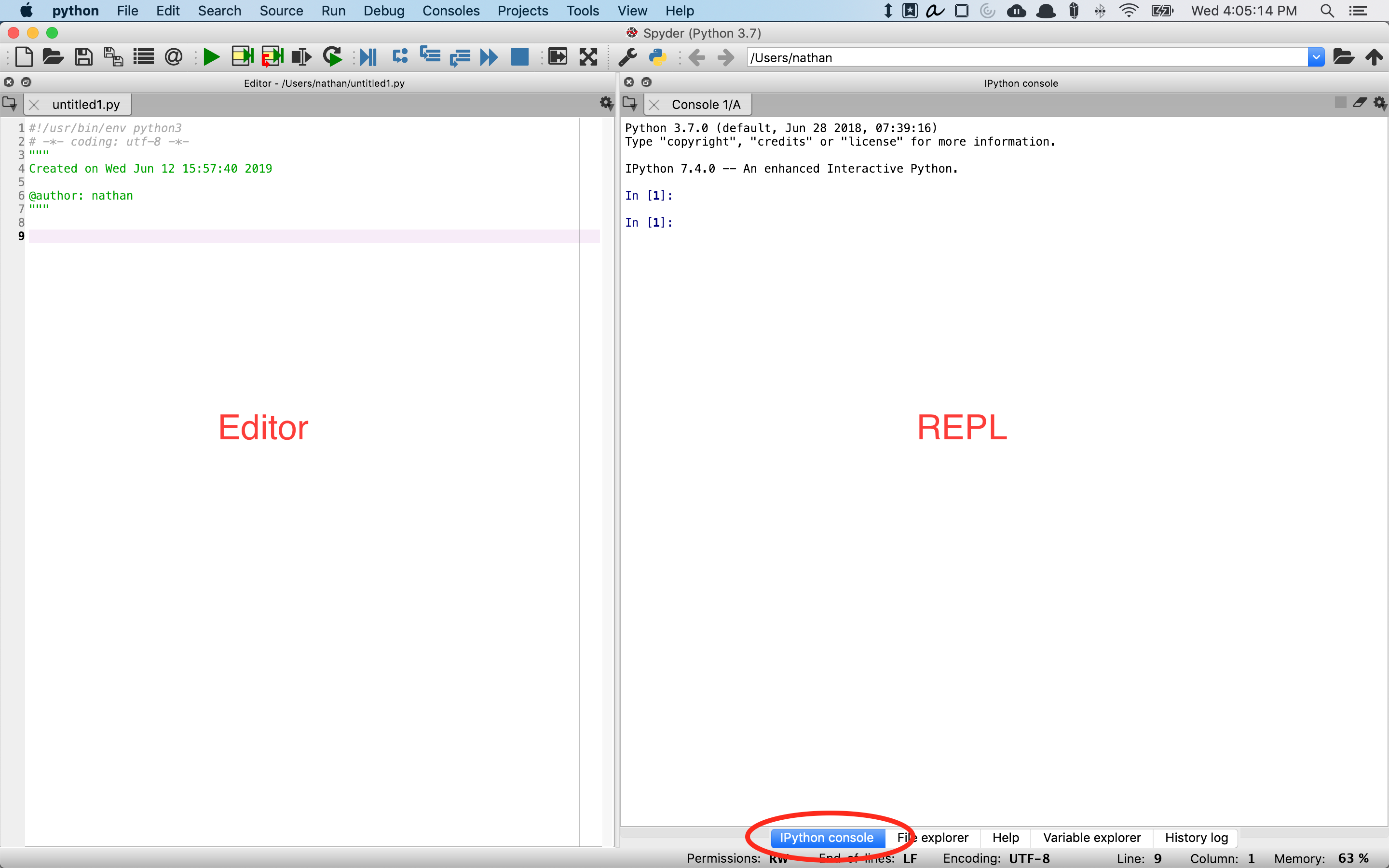Installing and Getting Up and Running with Python
Here I'll explain how to install and use Python, a free, open source programming language.
If you're reading this, it's probably because you want to be able to run Python 3 code and install packages. If you can already do that and have a setup that works for you, great. If you do not, the easiest way to get one is from Anaconda.
Go to:
https://www.anaconda.com/distribution/
Scroll down and click on the green button to download the 3.x version (3.7 at time of this writing) for your operating system.

Then install it. It might ask whether you want to install it for everyone on your computer or just you. Installing it for just yourself is fine.
One potential downside to a program like Anaconda is that it takes up a lot of disk space. This shouldn't be a big deal. Most computers have much more hard disk space than they need and using it will not slow your computer down. Once you are more familiar with Python, you may want to explore other, more minimalistic ways of installing it.
Once you have Anaconda installed, open up Anaconda navigator and launch Spyder.
Then go to View -> Window layouts and click on Horizontal split.
Make sure pane selected (in blue) on the right side is 'IPython console'
Now you should be ready to code. Your editor is on left, and your Python console is on the right. Let's touch on each of these briefly.

Code
Most people reading this have probably worked with something like Excel previously, but not necessarily code. What are the differences?
A spreadsheet lets you manipulate a table of data as you look at. You can point, click, resize columns, change cells, etc. The coder term for this style of interaction is "what you see is what you get" (WYSIWYG).
Python code, in contrast, is a set of instructions for working with data. You tell your program what to do, and Python does (executes) it.
It is possible to tell Python what to do one instruction at a time, but usually programmers write multiple instructions out at once. These instructions are called "programs" or "code", and are just plain text files with the extension .py.
When you tell Python to run some program, it will look at the file and run each line, starting at the top.
Editor
Your editor is the text editing program you use to write and edit these files. If you wanted, you could write all your Python programs in Notepad, but most people don't. An editor like Spyder will do nice things like highlight special, Python related keywords and alert you if something doesn't look like proper code.
Console (REPL)
Your editor is the place to type code. The place where you actually run code is in what Spyder calls the IPython console. The IPython console is an example of what programmers call a read-eval(uate)-print-loop, or REPL.
A REPL does exactly what the name says, takes in ("reads") some code, evaluates it, and prints the result. Then it automatically "loops" back to the beginning and is ready for some new code.
Try typing 1+1 into it. You should see:
In [1]: 1 + 1
Out[1]: 2
The REPL "reads" 1 + 1, evaluates it (it equals 2), and prints it. The REPL
is then ready for new input.
A REPL keeps track of what you have done previously. For example if you type:
In [2]: x = 1
And then later:
In [3]: x + 1
Out[3]: 2
the REPL prints out 2. But if you quit and restart Spyder and try typing x +
1 again it will complain that it doesn't know what x is.
In [1]: x + 1
...
NameError: name 'x' is not defined
By Spyder "complaining" I mean that Python gives you an error. An error —
also sometimes called an exception — means something is wrong with your
code. In this case, you tried to use x without telling Python what x was.
Get used to exceptions, because you'll run into them a lot. If you are working interactively in a REPL and do something against the rules of Python it will alert you (in red) that something went wrong, ignore whatever you were trying to do, and loop back to await further instructions like normal.
Try:
In [2]: x = 9/0
...
ZeroDivisionError: division by zero
Since dividing by 0 is against the laws of math1, Python won't let you do it
and will throw (raise) an error. No big deal — your computer didn't crash and
your data is still there. If you type x in the REPL again you will see
it's still 1.
Python behaves a bit differently if you have an error in a file you are trying to run all at once. In that case Python will stop executing the file, but because Python executes code from top to bottom everything above the line with your error will have run like normal.
Using Spyder
When writing programs (or following along with examples other people have written) you will spend a lot of your time in the editor. You will also often want to send (run) code — sometimes the entire file, usually just certain sections — to the REPL. You also should go over to the REPL to examine certain variables or try out certain code.
At a minimum, I recommend getting comfortable with the following keyboard shortcuts in Spyder:
Pressing F9 in the editor will send whatever code you have highlighted to the REPL. If you don't have anything highlighted, it will send the current line.
F5 will send the entire file to the REPL.
control + shift + e moves you to the editor (e.g. if you're in the REPL). On a Mac, it's command + shift + e.
control + shift + i moves you to the REPL (e.g. if you're in the editor). On a Mac, it's command + shift + i.